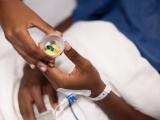Aug 26, 2011 (CIDRAP News) – Australian public health officials yesterday reported a cluster of oseltamivir (Tamiflu)-resistant 2009 H1N1 infections, one of the largest to date, centered in one region of New South Wales state.
Between May and August, 25 (14%) of 184 2009 H1N1 cases in the Hunter New England region of New South Wales have shown reduced sensitivity to oseltamivir due to the H275Y mutation, the group said in a report posted on ProMED Mail, the online reporting system of the International Society for Infectious Diseases.
Though smaller clusters of oseltamivir-resistant 2009 H1N1 infections have been detected mainly in healthcare settings where patients were treated with antivirals, none of the 16 patients interviewed so far had been treated with the drug.
Five were hospitalized when specimens were collected, and none had a history of immune suppression, the authors reported. Three of the cases were in pregnant women. None of the patients were admitted to the intensive care unit or died.
Fifteen of the first 16 cases live within a 50-km radius of Newcastle, the regional center.
Further interviews with the patients who had oseltamivir-resistant infections are ongoing, and more detailed virologic analysis of the isolates is under way, according to the report.
Dr Jennifer McKimm-Breschkin, an antiviral expert at Commonwealth Science and Industrial Research Organization in Melbourne, said the Australian cluster is the largest to date involving the H275Y mutation and the 2009 H1N1 virus, Bloomberg News reported yesterday. She said the report suggests that the virus can transmit efficiently and without drug pressure and speculated that a treated patient may have passed the variant on to others.
The World Health Organization (WHO) said in a June surveillance update that the detection rate for oseltamivir-resistant 2009 H1N1 viruses is very low, at 1.5%, based on routine testing at five of its collaborating centers. Overall, the monthly detection rate increased slightly after October 2010, then declined in March. It added that patterns vary at different centers.
Clinical history has also varied by region, the WHO reported. In Japan most oseltamivir-resistant cases involved patients who received treatment of prophylaxis, but in the United Kingdom the percentage of resistant infections with no known exposure to the drug increased from 11% during the 2009-10 season to at least 28% during the 2010-11 season.
Dr Ian Barr, deputy director of the WHO's Collaborating Center for Influenza in Melbourne told Bloomberg that the cluster is only worrisome if it spreads beyond the Newcastle area. "Fortunately, we're heading toward the end of our flu season," he added.
Global update shows some hot spots
In a global influenza update today, the WHO said flu activity in Australia is increasing, based on rising levels of doctors' visits for flu-like illness and the number of lab-confirmed flu infections. It said the 2009 H1N1 virus and influenza B are co-circulating in the country, with varying distribution.
In neighboring New Zealand, where influenza B is the dominant strain, flu activity is at expected levels for this time of year, the WHO said. The Southern Hemisphere's flu season usually runs from May through October.
Flu activity is low in tropical locales, except in a few areas of the Americas, Western Africa, and Southern Asia. Hot spots include Cuba and Honduras, where the influenza A (H3N2) virus is dominant. Flu transmission continues in the Dominican Republic, which is now seeing a larger proportion of influenza B. Elsewhere, flu transmission is increasing in Cameroon, which is reporting mostly influenza B, with some circulation of 2009 H1N1.
The areas of greatest flu activity in South Asia include Bangladesh, India, and Thailand, which are reporting mainly H3N2 with smaller numbers of influenza B and 2009 H1N1.
Northern Hemisphere countries are reporting low or no flu activity, which is typical for the interseasonal period, the WHO said.
US flu markers stay low
In the United States, flu markers showed very low flu activity, with doctors' visits for flu-like activity at 0.5%, putting it well below the 2.5% baseline, the Centers for Disease Control and Prevention (CDC) said today in its report for the week ending Aug 20. Deaths for flu and pneumonia were also well below the baseline for this time of year, and no pediatric flu deaths were reported.
See also:
Aug 25 ProMed post
Jun 6 WHO report on antiviral susceptibility surveillance
Aug 25 Bloomberg News story
Aug 26 WHO global flu update
Aug 26 CDC flu surveillance update





















